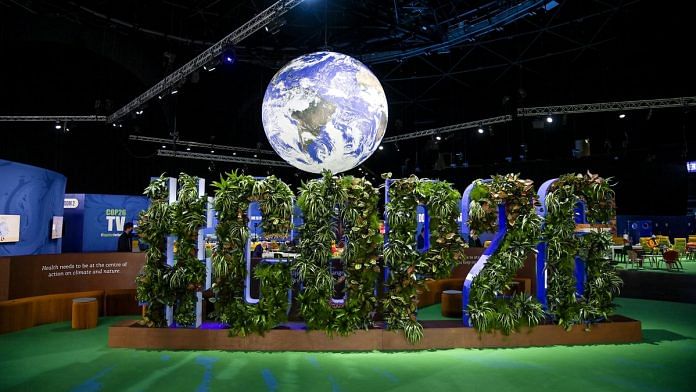New Delhi: Developed countries should deliver “at least” US $1.3 trillion per year between 2025 and 2030 in climate finance, split equally between climate mitigation and adaptation, the African Group (comprising 54 countries), backed by the Like Minded Developing Countries (24, including India) has proposed at the ongoing COP26 in Glasgow, ThePrint has learnt.
However, developed nations involved in the negotiations have resisted discussion on this proposal, and have pushed back on certain aspects of it, negotiators told ThePrint on the condition of anonymity.
The proposal has been put forth as a working draft text that seeks to figure out the contours of long-term climate finance after 2025, under the Paris Agreement. ThePrint has seen the draft text.
Developed countries had made a commitment in 2009 to deliver $100 billion in climate finance to developing nations every year, up to 2020. In the Paris Agreement, this period was extended till 2025.
But developed nations never raised this amount, and have admitted that they won’t be able to do so before 2023 — three years after the original deadline.
The new collective goal on climate finance will serve from 2025, once the commitment period for the $100 billion has lapsed, to help developing nations achieve their climate goals while also mitigating and adapting to climate change.
Developing countries have argued that climate finance is essential to driving their climate ambitions and achieving their targets under the Paris Agreement.
The run-up to the second week of negotiations saw a spate of announcements and pledges to increase climate finance by developed nations, but developing nations have repeatedly said this will fall short, and that this contrasts how negotiations have been unfolding within closed doors.
The aim of the new proposal, which will be submitted to the COP26 Presidency after negotiations are over, is “to initiate the deliberations on setting a new collective quantified goal on finance” well in time, so there are no delays in its implementation.
Developed countries like Australia, the US, and Norway have opposed some of the proposals in the draft text, negotiators said.
“Pushback is largely on not wanting to talk about any figure (for climate finance), but also the process itself. The developed countries do not want a robust process behind the new climate goal. They want a bunch of workshops and then for the political leadership to decide on the figure,” said a senior negotiator from the African Group.
Also read: There’s an $80 billion hole in India’s net zero pledge at COP26
$1.3 trillion figure ‘not the most important’
Negotiators told ThePrint that the figure of $1.3 trillion isn’t the main focus of the long-term climate finance talks; initiating discussions on the figure is.
“The decision is all about initiating the deliberations, and trying to come up with a time to conclude them. The notion is to move away from the $100 billion figure, which was decided without any real scientific reasoning,” said the negotiator quoted above.
“We are looking at what kind of process it (the new goal) will have, what would be the issues to deal with, how to initiate the work, and the timelines,” the negotiator said.
Like Minded Developing Countries support the formation of an ad-hoc committee, which will “conduct the technical analysis and undertake multilateral consultations on the new collective quantified goal”. They also seek, along with the African Group, “adequate resources for loss and damage”.
Developed countries oppose this in favour of workshops and seminars.
“We need to have an entity that will follow up with the roadmap that comes out of these negotiations on the new climate goal. There is a need to have a common understanding and definition of climate finance, which our partner developed countries don’t want. An ad hoc committee can do this,” said Diego Pacheco, spokesperson for the LDMCs.
The proposal also demands “adequate resources for loss and damage”, which developed countries have resisted.
The $1.3 trillion figure was arrived at by the African Group, after using the Global Environment Facility’s co-financing ratio, using the $100 billion goal as a baseline.
Prime Minister Narendra Modi had also demanded $1 trillion from developing countries when he announced India’s new climate commitments. However, he didn’t provide any further details on the demand.
“The figure is not that important per se. The idea is that we move on from the $100 billion goal to something more realistic and ambitious,” said the African Group negotiator quoted above.
A report by the Standing Committee on Finance under the United Nations Framework Convention on Climate Change (UNFCCC) — the mother convention under which the COP is held annually — had said developing nations would need $5.8-$5.9 trillion every year till 2030 to achieve less than half of their climate goals under the Paris Agreement.
Negotiations at the COP26 meet in Glasgow will continue till 12 November.
This report has been corrected to reflect that the developed countries’ $100 billion commitment was up to 2020, not starting in that year. The error is regretted.
(Edited by Amit Upadhyaya)
Also read: Lack of serious approach to climate finance will jeopardise net zero pledges, India says



